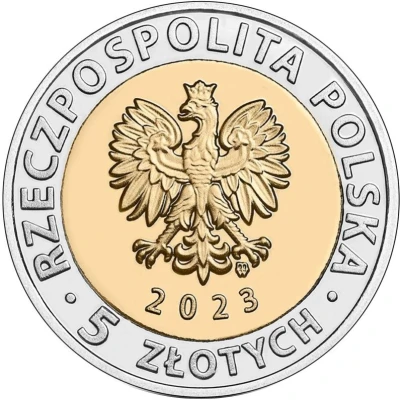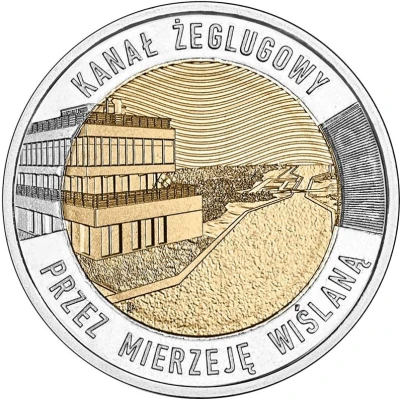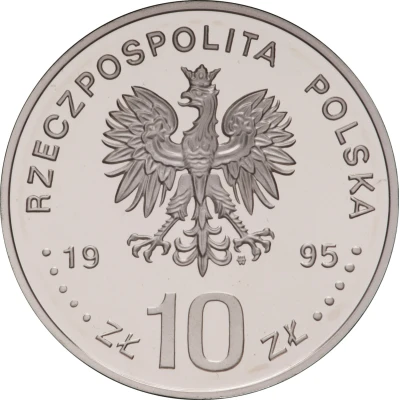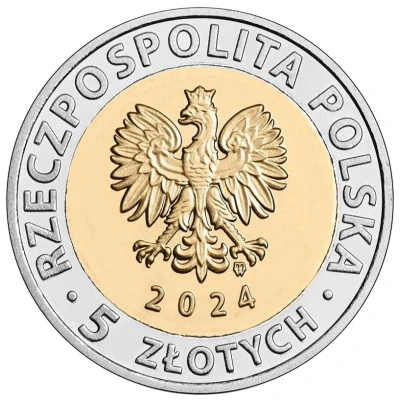
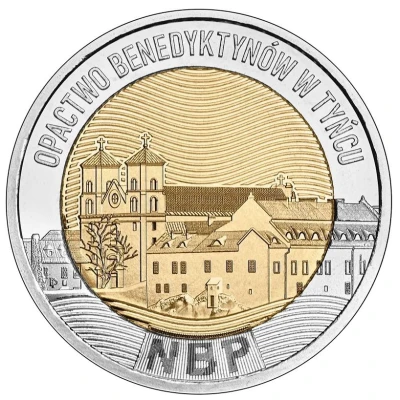

5 Zlotys Benedictine Abbey in Tyniec
2024 year| Bimetallic: aluminium bronze centre in copper-nickel ring (ring: MN25 | core: CuAl6Ni2) | 6.54 g | 24 mm |
| Issuer | Poland |
|---|---|
| Period | Third Republic (1989-date) |
| Type | Circulating commemorative coin |
| Year | 2024 |
| Value | 5 Zlotys (5 Złotych) 5 PLN = USD 1.27 |
| Currency | Fourth Zloty (1995-date) |
| Composition | Bimetallic: aluminium bronze centre in copper-nickel ring (ring: MN25 | core: CuAl6Ni2) |
| Weight | 6.54 g |
| Diameter | 24 mm |
| Thickness | 2 mm |
| Shape | Round |
| Technique | Milled |
| Orientation | Medal alignment ↑↑ |
| Updated | 2024-10-07 |
| Numista | N#416735 |
|---|---|
| Rarity index | 37% |
Reverse
The building of the The Benedictine Abbey in Tyniec.
Script: Latin
Lettering:
OPACTWO BENEDYKTYNÓW W TYŃCU
NBP
PP
Translation: THE BENEDICTINE ABBEY IN TYNIEC
Designer: Paweł Pietras
Edge
Irregularly reeded with inscription: “NBP”, repeated eight times, every second one inverted by 180°, separated by stars
Script: Latin
Lettering: NBP✶NBP✶NBP✶NBP✶NBP✶NBP✶NBP✶NBP✶
Comment
The Benedictine Abbey in Tyniec, founded in 1044, is the oldest existing monastery in Poland. Thus, it is a unique witness to the development of monasticism in Europe and to the long and turbulent history of Poland: from the dawn of statehood, through the Golden Age, the partitions, to its rebirth in the 20th century.
The oldest preserved parts of the monastery date from the turn of the 11th and 12th centuries. In 1125, the Romanesque basilica was consecrated. Subsequent reconstructions and architectural details reflect the transformations in Polish art that took place over the centuries - there are Gothic cloisters and church walls, Renaissance vaults and polychromes, Mannerist and Baroque decor with furnishings. Archaeological work carried out after World War II uncovered the remains of the oldest architecture of the monastic complex: the foundations and lower parts of the Romanesque walls of the basilica and refectory, the floors, as well as burial sites from the 11th and 12th centuries with valuable grave furnishings.
The special role of the Tyniec Abbey in the consciousness of Poles is evidenced by the period of the Partitions of Poland, as a result of which the monastery was liquidated. In spite of this, it remained in the popular memory, as can be seen in the novel ‘Krzyżacy’ by Henryk Sienkiewicz (the action of the book begins in Tyniec, and there is also a rich description of the monastery and the legends associated with it) and in the painting ‘Widok Tyńca’ (The View of Tyniec) by Saturnin Świerzyński, dating from 1867 and housed in the National Museum in Kraków. It depicts a landscape, typical of the period, of a place close to the Poles, comforting them at the time of the partitions. Tyniec and its ruins also inspired other writers and artists - Stefan Żeromski or Teodor Parnicki.
During the reconstruction of the monastery in the post-war period, a set of twin Romanesque capitals dating back to around 1100 was discovered. One of them shows a beautiful bas-relief palmette motif, which was reproduced on a circulating ten-zloty banknote.
Interesting fact
One interesting fact about this coin is that it features a unique bimetallic design, with an aluminum bronze center surrounded by a copper-nickel ring. This distinctive design element adds an extra layer of visual interest to the coin and sets it apart from other coins in circulation.
Price
| Date | Mintage | VG | F | VF | XF | AU | UNC |
|---|---|---|---|---|---|---|---|
| 2024 MW | 1000000 | - | - | - | - | - | - |
Values in the table are based on evaluations by sales realized on Internet platforms. They serve as an indication only for 5 Zlotys (Benedictine Abbey in Tyniec) 2024 coin.
